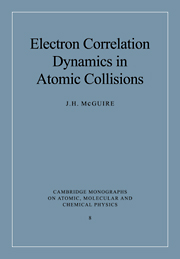Book contents
- Frontmatter
- Contents
- Preface
- 1 Introduction
- 2 Single electron transition probabilities
- 3 Formulation of multi-electron transition probabilities
- 4 Independent electron approximation
- 5 Statistical methods
- 6 Correlated multi-electron electron transition probabilities
- 7 Perturbation expansions
- 8 Projectiles carrying electrons
- 9 Reactions with photons
- 10 Relations between charged particle and photon reactions
- Appendices
- References
- Index
Preface
Published online by Cambridge University Press: 11 September 2009
- Frontmatter
- Contents
- Preface
- 1 Introduction
- 2 Single electron transition probabilities
- 3 Formulation of multi-electron transition probabilities
- 4 Independent electron approximation
- 5 Statistical methods
- 6 Correlated multi-electron electron transition probabilities
- 7 Perturbation expansions
- 8 Projectiles carrying electrons
- 9 Reactions with photons
- 10 Relations between charged particle and photon reactions
- Appendices
- References
- Index
Summary
One of the central questions of science is: how are complex things made from simple things? In many cases larger systems are more complicated than their smaller subsystems. In biology and chemistry the issue is how to understand large molecules in terms of atoms. In atomic physics one may strive to understand properties of many electron systems in terms of single electron properties. The general theme is interdependency of subsystems, or ‘correlation’.
Correlation may be regarded as a conceptual bridge from properties of individuals to properties of groups or families. In atoms and molecules correlation occurs because electrons interact with one another – the electrons are interdependent. This electron correlation determines much of the structure and dynamics of many electron systems, i.e., how complex electronic systems are made from single electrons. Complexity is the more significant idea, but complexity may be seldom, if ever, understood. Correlation is the key to complexity.
Understandably, much has been done on the correlation of static systems. There are many excellent methods and computer codes to evaluate energies and wavefunctions for complex atomic and molecular systems. However, the dynamics of these many electron systems is less well understood. Hence, the dynamics of electron correlation is a central theme in this book.
The dynamics of electron correlation may affect single electron transitions. However, this effect is sometimes difficult to separate from other effects.
- Type
- Chapter
- Information
- Electron Correlation Dynamics in Atomic Collisions , pp. xiii - xivPublisher: Cambridge University PressPrint publication year: 1997

